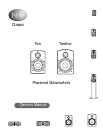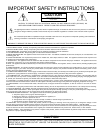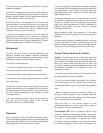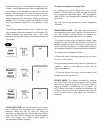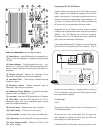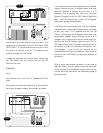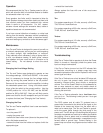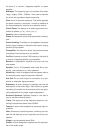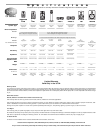the back of a receiver, integrated amplifier or power
amplifier.
Midrange: The frequency span in the middle of the audio
range, roughly 180Hz - 3000Hz. Also used to describe
the driver that reproduces these frequencies.
Ohm: A unit of electrical resistance. That which opposes
an electric current in a conductor. In audio, a measure of
the load presented by a device to an electrical source.
Out-of-Phase: The polarity of an audio signal when con-
nected as follows: (+) to (-) and (-) to (+).
Passive: Uses no electrical power.
Phase: An expression of the relative polarities of two sig-
nals.
Power Handling: The ability of a loudspeaker to operate
without large increases in distortion when given varying
amounts of input power.
Preamplifier: An electronic device that selects sources
and passes line-level signals to an amplifier.
Pre-Out: A preamp line-level RCA output on the back of
a receiver, integrated amplifier or preamplifier.
Receiver: A preamplifier, amplifier and tuner built into
one chassis.
Satellite: Front L & R speakers when used with a sub-
woofer. Also referred to as "main speakers".
Sensitivity: A ratio of voltage across the speaker load to
the acoustic power output, measured in decibels.
Sub Out: An line level output for connection to a sub-
woofer or subwoofer signal processor.
Subwoofer: A driver designed to operate over the low
bass portion of the audio range. Also refers to a system
consisting of a woofer and its enclosure, which are phys-
ically separate from the upper range loudspeakers.
Surround Speakers: Speakers located in the side or
rear for surround channel effects.
Treble: The upper part of the frequency spectrum, con-
sisting of frequencies above about 3000Hz.
Tweeter: A small driver designed to reproduce high fre-
quencies.
Watt: A measure of electrical power, combining the volt-
age with the electrical current required to drive the loud-
speaker.
Weight: Low frequencies below 50Hz.
Woofer: A driver designed to operate over the bass por-
tion of the audio range.



